Sridhar Mahadevan
Consciousness as a Functor
Aug 25, 2025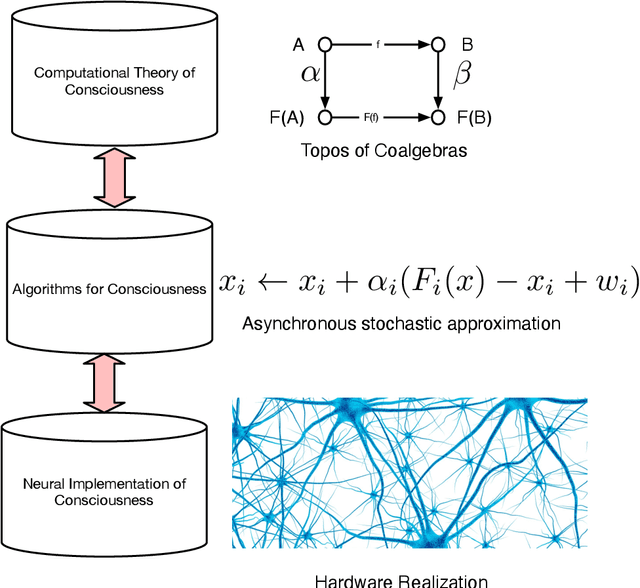
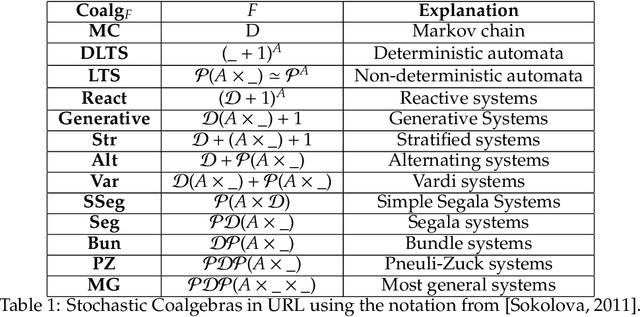
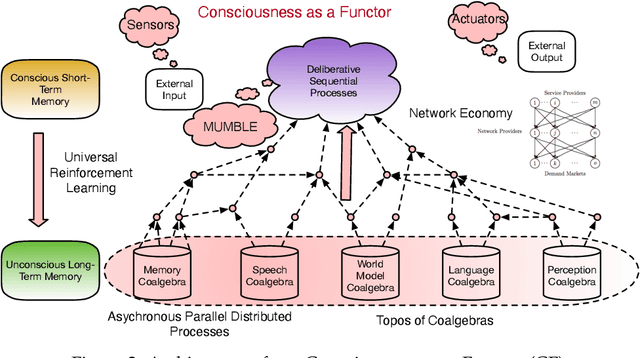
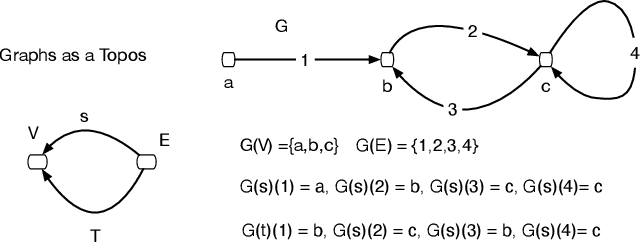
Abstract:We propose a novel theory of consciousness as a functor (CF) that receives and transmits contents from unconscious memory into conscious memory. Our CF framework can be seen as a categorial formulation of the Global Workspace Theory proposed by Baars. CF models the ensemble of unconscious processes as a topos category of coalgebras. The internal language of thought in CF is defined as a Multi-modal Universal Mitchell-Benabou Language Embedding (MUMBLE). We model the transmission of information from conscious short-term working memory to long-term unconscious memory using our recently proposed Universal Reinforcement Learning (URL) framework. To model the transmission of information from unconscious long-term memory into resource-constrained short-term memory, we propose a network economic model.
Universal Reinforcement Learning in Coalgebras: Asynchronous Stochastic Computation via Conduction
Aug 20, 2025Abstract:In this paper, we introduce a categorial generalization of RL, termed universal reinforcement learning (URL), building on powerful mathematical abstractions from the study of coinduction on non-well-founded sets and universal coalgebras, topos theory, and categorial models of asynchronous parallel distributed computation. In the first half of the paper, we review the basic RL framework, illustrate the use of categories and functors in RL, showing how they lead to interesting insights. In particular, we also introduce a standard model of asynchronous distributed minimization proposed by Bertsekas and Tsitsiklis, and describe the relationship between metric coinduction and their proof of the Asynchronous Convergence Theorem. The space of algorithms for MDPs or PSRs can be modeled as a functor category, where the co-domain category forms a topos, which admits all (co)limits, possesses a subobject classifier, and has exponential objects. In the second half of the paper, we move on to universal coalgebras. Dynamical system models, such as Markov decision processes (MDPs), partially observed MDPs (POMDPs), a predictive state representation (PSRs), and linear dynamical systems (LDSs) are all special types of coalgebras. We describe a broad family of universal coalgebras, extending the dynamic system models studied previously in RL. The core problem in finding fixed points in RL to determine the exact or approximate (action) value function is generalized in URL to determining the final coalgebra asynchronously in a parallel distributed manner.
GAIA: Categorical Foundations of Generative AI
Feb 28, 2024



Abstract:In this paper, we propose GAIA, a generative AI architecture based on category theory. GAIA is based on a hierarchical model where modules are organized as a simplicial complex. Each simplicial complex updates its internal parameters biased on information it receives from its superior simplices and in turn relays updates to its subordinate sub-simplices. Parameter updates are formulated in terms of lifting diagrams over simplicial sets, where inner and outer horn extensions correspond to different types of learning problems. Backpropagation is modeled as an endofunctor over the category of parameters, leading to a coalgebraic formulation of deep learning.
Zero-th Order Algorithm for Softmax Attention Optimization
Jul 17, 2023Abstract:Large language models (LLMs) have brought about significant transformations in human society. Among the crucial computations in LLMs, the softmax unit holds great importance. Its helps the model generating a probability distribution on potential subsequent words or phrases, considering a series of input words. By utilizing this distribution, the model selects the most probable next word or phrase, based on the assigned probabilities. The softmax unit assumes a vital function in LLM training as it facilitates learning from data through the adjustment of neural network weights and biases. With the development of the size of LLMs, computing the gradient becomes expensive. However, Zero-th Order method can approximately compute the gradient with only forward passes. In this paper, we present a Zero-th Order algorithm specifically tailored for Softmax optimization. We demonstrate the convergence of our algorithm, highlighting its effectiveness in efficiently computing gradients for large-scale LLMs. By leveraging the Zeroth-Order method, our work contributes to the advancement of optimization techniques in the context of complex language models.
Randomized and Deterministic Attention Sparsification Algorithms for Over-parameterized Feature Dimension
Apr 10, 2023Abstract:Large language models (LLMs) have shown their power in different areas. Attention computation, as an important subroutine of LLMs, has also attracted interests in theory. Recently the static computation and dynamic maintenance of attention matrix has been studied by [Alman and Song 2023] and [Brand, Song and Zhou 2023] from both algorithmic perspective and hardness perspective. In this work, we consider the sparsification of the attention problem. We make one simplification which is the logit matrix is symmetric. Let $n$ denote the length of sentence, let $d$ denote the embedding dimension. Given a matrix $X \in \mathbb{R}^{n \times d}$, suppose $d \gg n$ and $\| X X^\top \|_{\infty} < r$ with $r \in (0,0.1)$, then we aim for finding $Y \in \mathbb{R}^{n \times m}$ (where $m\ll d$) such that \begin{align*} \| D(Y)^{-1} \exp( Y Y^\top ) - D(X)^{-1} \exp( X X^\top) \|_{\infty} \leq O(r) \end{align*} We provide two results for this problem. $\bullet$ Our first result is a randomized algorithm. It runs in $\widetilde{O}(\mathrm{nnz}(X) + n^{\omega} ) $ time, has $1-\delta$ succeed probability, and chooses $m = O(n \log(n/\delta))$. Here $\mathrm{nnz}(X)$ denotes the number of non-zero entries in $X$. We use $\omega$ to denote the exponent of matrix multiplication. Currently $\omega \approx 2.373$. $\bullet$ Our second result is a deterministic algorithm. It runs in $\widetilde{O}(\min\{\sum_{i\in[d]}\mathrm{nnz}(X_i)^2, dn^{\omega-1}\} + n^{\omega+1})$ time and chooses $m = O(n)$. Here $X_i$ denote the $i$-th column of matrix $X$. Our main findings have the following implication for applied LLMs task: for any super large feature dimension, we can reduce it down to the size nearly linear in length of sentence.
An Over-parameterized Exponential Regression
Mar 29, 2023Abstract:Over the past few years, there has been a significant amount of research focused on studying the ReLU activation function, with the aim of achieving neural network convergence through over-parametrization. However, recent developments in the field of Large Language Models (LLMs) have sparked interest in the use of exponential activation functions, specifically in the attention mechanism. Mathematically, we define the neural function $F: \mathbb{R}^{d \times m} \times \mathbb{R}^d \rightarrow \mathbb{R}$ using an exponential activation function. Given a set of data points with labels $\{(x_1, y_1), (x_2, y_2), \dots, (x_n, y_n)\} \subset \mathbb{R}^d \times \mathbb{R}$ where $n$ denotes the number of the data. Here $F(W(t),x)$ can be expressed as $F(W(t),x) := \sum_{r=1}^m a_r \exp(\langle w_r, x \rangle)$, where $m$ represents the number of neurons, and $w_r(t)$ are weights at time $t$. It's standard in literature that $a_r$ are the fixed weights and it's never changed during the training. We initialize the weights $W(0) \in \mathbb{R}^{d \times m}$ with random Gaussian distributions, such that $w_r(0) \sim \mathcal{N}(0, I_d)$ and initialize $a_r$ from random sign distribution for each $r \in [m]$. Using the gradient descent algorithm, we can find a weight $W(T)$ such that $\| F(W(T), X) - y \|_2 \leq \epsilon$ holds with probability $1-\delta$, where $\epsilon \in (0,0.1)$ and $m = \Omega(n^{2+o(1)}\log(n/\delta))$. To optimize the over-parameterization bound $m$, we employ several tight analysis techniques from previous studies [Song and Yang arXiv 2019, Munteanu, Omlor, Song and Woodruff ICML 2022].
A Layered Architecture for Universal Causality
Dec 18, 2022Abstract:We propose a layered hierarchical architecture called UCLA (Universal Causality Layered Architecture), which combines multiple levels of categorical abstraction for causal inference. At the top-most level, causal interventions are modeled combinatorially using a simplicial category of ordinal numbers. At the second layer, causal models are defined by a graph-type category. The non-random ``surgical" operations on causal structures, such as edge deletion, are captured using degeneracy and face operators from the simplicial layer above. The third categorical abstraction layer corresponds to the data layer in causal inference. The fourth homotopy layer comprises of additional structure imposed on the instance layer above, such as a topological space, which enables evaluating causal models on datasets. Functors map between every pair of layers in UCLA. Each functor between layers is characterized by a universal arrow, which defines an isomorphism between every pair of categorical layers. These universal arrows define universal elements and representations through the Yoneda Lemma, and in turn lead to a new category of elements based on a construction introduced by Grothendieck. Causal inference between each pair of layers is defined as a lifting problem, a commutative diagram whose objects are categories, and whose morphisms are functors that are characterized as different types of fibrations. We illustrate the UCLA architecture using a range of examples, including integer-valued multisets that represent a non-graphical framework for conditional independence, and causal models based on graphs and string diagrams using symmetric monoidal categories. We define causal effect in terms of the homotopy colimit of the nerve of the category of elements.
Privacy Aware Experiments without Cookies
Nov 03, 2022



Abstract:Consider two brands that want to jointly test alternate web experiences for their customers with an A/B test. Such collaborative tests are today enabled using \textit{third-party cookies}, where each brand has information on the identity of visitors to another website. With the imminent elimination of third-party cookies, such A/B tests will become untenable. We propose a two-stage experimental design, where the two brands only need to agree on high-level aggregate parameters of the experiment to test the alternate experiences. Our design respects the privacy of customers. We propose an estimater of the Average Treatment Effect (ATE), show that it is unbiased and theoretically compute its variance. Our demonstration describes how a marketer for a brand can design such an experiment and analyze the results. On real and simulated data, we show that the approach provides valid estimate of the ATE with low variance and is robust to the proportion of visitors overlapping across the brands.
Unifying Causal Inference and Reinforcement Learning using Higher-Order Category Theory
Sep 13, 2022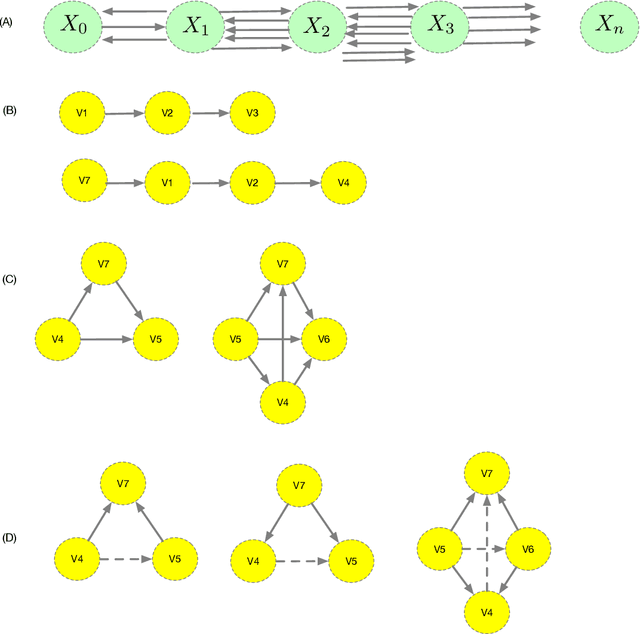


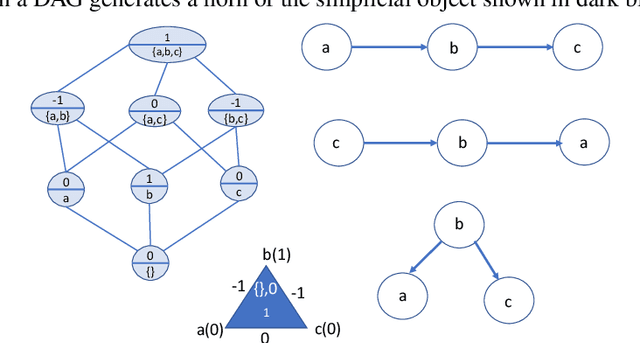
Abstract:We present a unified formalism for structure discovery of causal models and predictive state representation (PSR) models in reinforcement learning (RL) using higher-order category theory. Specifically, we model structure discovery in both settings using simplicial objects, contravariant functors from the category of ordinal numbers into any category. Fragments of causal models that are equivalent under conditional independence -- defined as causal horns -- as well as subsequences of potential tests in a predictive state representation -- defined as predictive horns -- are both special cases of horns of a simplicial object, subsets resulting from the removal of the interior and the face opposite a particular vertex. Latent structure discovery in both settings involve the same fundamental mathematical problem of finding extensions of horns of simplicial objects through solving lifting problems in commutative diagrams, and exploiting weak homotopies that define higher-order symmetries. Solutions to the problem of filling "inner" vs "outer" horns leads to various notions of higher-order categories, including weak Kan complexes and quasicategories. We define the abstract problem of structure discovery in both settings in terms of adjoint functors between the category of universal causal models or universal decision models and its simplicial object representation.
Categoroids: Universal Conditional Independence
Aug 24, 2022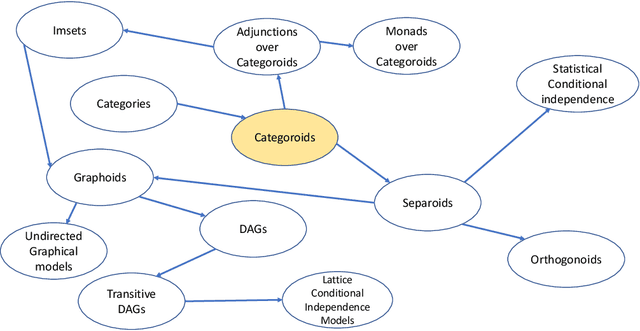
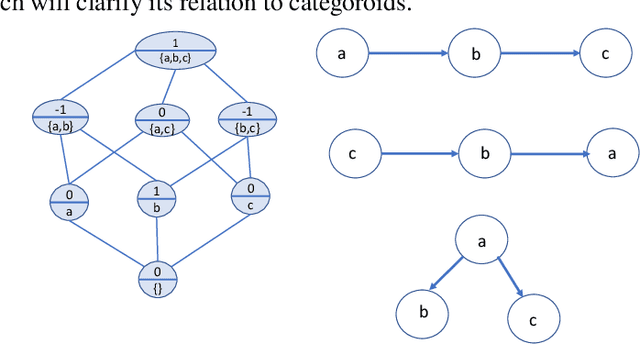
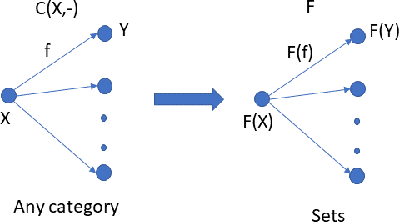
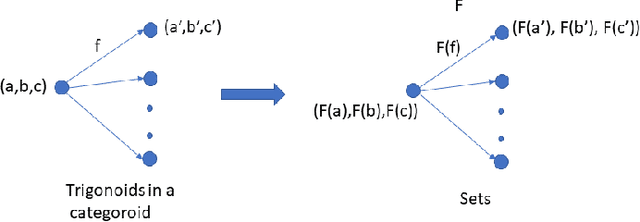
Abstract:Conditional independence has been widely used in AI, causal inference, machine learning, and statistics. We introduce categoroids, an algebraic structure for characterizing universal properties of conditional independence. Categoroids are defined as a hybrid of two categories: one encoding a preordered lattice structure defined by objects and arrows between them; the second dual parameterization involves trigonoidal objects and morphisms defining a conditional independence structure, with bridge morphisms providing the interface between the binary and ternary structures. We illustrate categoroids using three well-known examples of axiom sets: graphoids, integer-valued multisets, and separoids. Functoroids map one categoroid to another, preserving the relationships defined by all three types of arrows in the co-domain categoroid. We describe a natural transformation across functoroids, which is natural across regular objects and trigonoidal objects, to construct universal representations of conditional independence.. We use adjunctions and monads between categoroids to abstractly characterize faithfulness of graphical and non-graphical representations of conditional independence.
 Add to Chrome
Add to Chrome Add to Firefox
Add to Firefox Add to Edge
Add to Edge